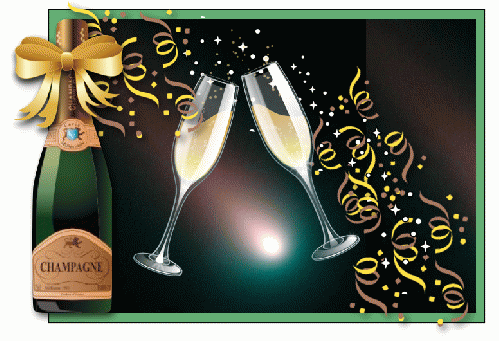Number nine in the monthly Uppity Women Wednesday Series, started in April, 2014.
What in heaven's name could a great comet, a greatly daring Frenchwoman, and a great glass of bubbly have in common? This triple cosmic intersection in 1811 produced one of history's most memorable moments. That year, an inventive winemaking widow named Barbe-Nicole Clicquot (pronounced klee-KOH) created the first modern champagne from a vintage so extraordinary that she named it after the comet that blazed across the skies above her. She dubbed her champagne "le vin de la comet."
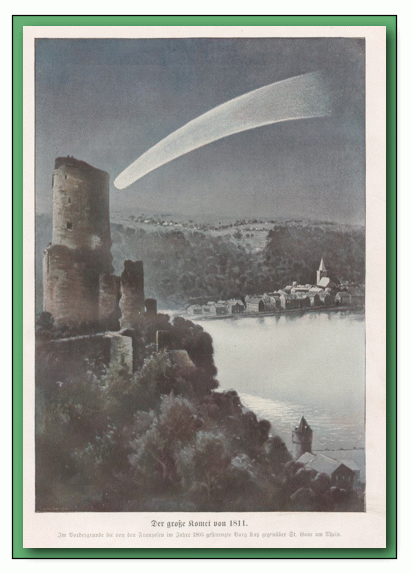
Great Comet of 1811 scene.
(Image by (From Wikimedia) CHR Schreiber, Author: CHR Schreiber) Details Source DMCA
The Great Comet, first spotted in March of 1811 by French skygazer Honore Flaugergues, had a shimmering tail that made a brilliant arc across the heavens. For nine months it lingered, visible to the naked eye night and day, gestating a sparking wine which would change the world .
Although comets historically had been viewed as signaling bad news, when it came to farming, people often believed the opposite. In France that year, most people thought that the growing season would be benevolently influenced by the heavenly presence. And, in fact, after years of poor harvests and dreadful weather, 1811 served up bumper crops, including the lifeblood of France--its wine grapes. Once it was made into wine, cognac, and champagne, that year's out-of-this-world grape harvest produced vintages that would be raved about for centuries.
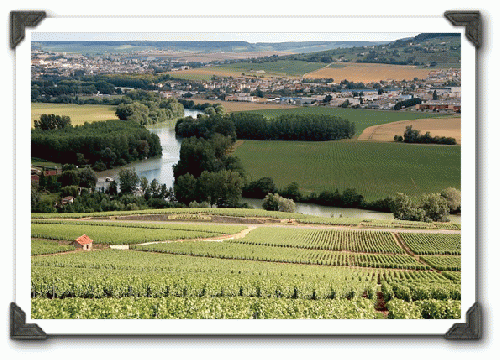
Vineyards in Champagne province
(Image by (From Wikimedia) Rob & Lisa Meehan, Author: Rob & Lisa Meehan) Details Source DMCA
The uniquely lovely liquid produced by Clicquot was especially notable, for not only its exquisite taste, but even more for its clarity and effervescent qualities. Prior to Mme. Clicquot's breakthrough, wine that went bubbly was believed to be wine that had gone wrong. How did this redoubtable single mom come up with such a heavenly new drink? And how did she manage to do this successfully in a male-dominated, gender-repressive society during those turbulent, Napoleonic, war-filled years?
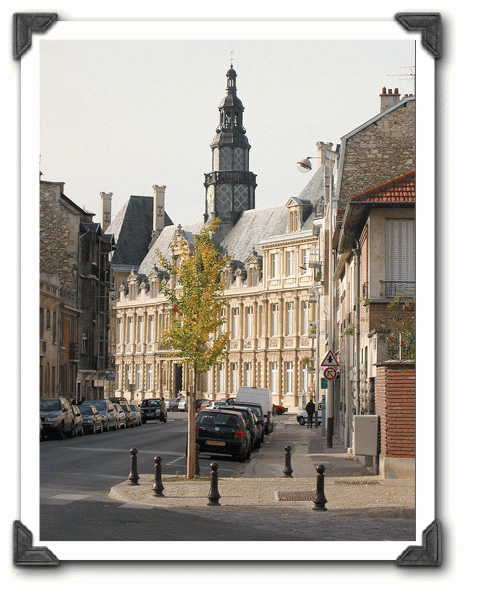
Barbe-Nicole's home town of Reims, France
(Image by (From Wikimedia) Magnus Manske, Author: Magnus Manske) Details Source DMCA
Her story
begins in Reims, where in 1777 Barbe-Nicole Ponsardin was born into an affluent
manufacturing family. Engaged in her teens, at 21 she made what was probably an
arranged marriage to Francois Cliquot of a rival business family. Nicole took
an immediate interest in her new family's business, a mix of wool importing and
banking, with a bit of viticulture as a sideline.
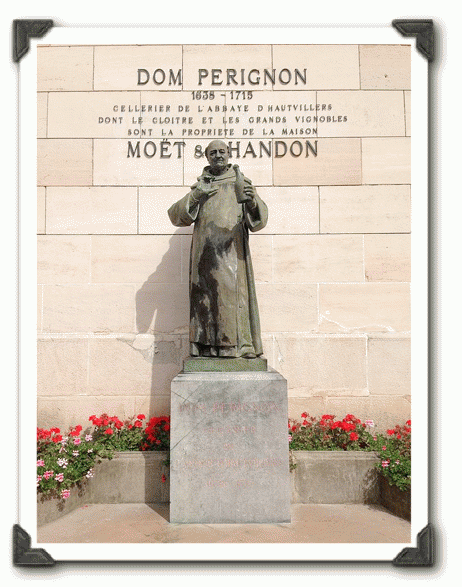
Statue of Dom Perignon.
(Image by (From Wikimedia) victorgrigas, Author: victorgrigas) Details Source DMCA
Miss Ponsardin and Francois were married in a wine cellar, and Nicole's fascination with winemaking may have been enriched by a wedding gift she received from the priest who married them--an 18th Century version of "Winemaking for Dummies." It was written by Dom Perignon, the monk who pioneered the French viticultural and fermentation techniques practiced today, and whose name still appears on an equally prestigious champagne.
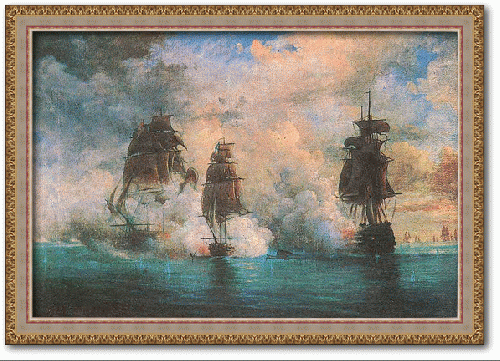
Painting of battleships by Nikolei Pavlovich Krasovsky
(Image by (From Wikimedia) Nikolei Pavlovich Krasovsky (1840 - 1906), Author: Nikolei Pavlovich Krasovsky (1840 - 1906)) Details Source DMCA
After just seven years of marriage, motherhood, and enjoying her 3-year-old daughter, tragedy struck when Nicole's husband died unexpectedly in 1805. At the time Europe was at war. Despite her sad personal loss and the ominous state of affairs in the larger world, she argued, cajoled, and nagged her father-in-law, to let her run the fledging wine business that her late husband had nurtured. Given that Nicole was clearly an uppity woman -- persuasive and with business acumen--he eventually caved and she had herself a winery.
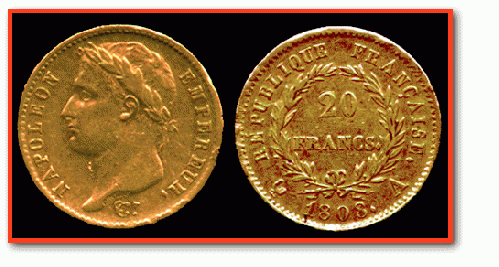
French gold coins feature Napoleon's profile.
(Image by (From Wikimedia) Coinman62 at English Wikipedia, Author: Coinman62 at English Wikipedia) Details Source DMCA
The new widow poured everything she had into her dream, including her own inheritance. Conditions, however, could not have been worse. Warfare and naval blockades throughout the British Isles and the nations around the Mediterranean basin made it almost impossible for traders and merchant ships to travel or land their goods. Prices fell, and so did the sales of her Champagne region wines. After a promising business partner lost heart and bailed, she found herself investing even more money into her venture.
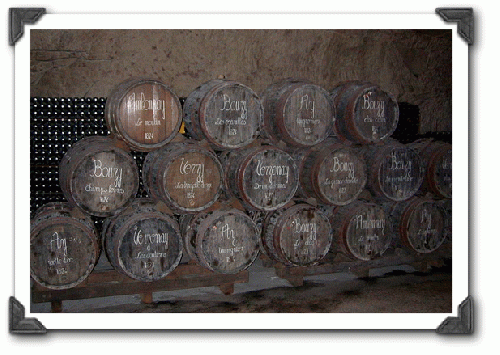
La Veuve Clicquot cellars, barrels with village and vineyard names.
(Image by (From Wikimedia) Tomas er, Author: Tomas er) Details Source DMCA
Nevertheless, Barbe-Nicole, who now called her wine business "La Veuve Clicquot" (The Widow Clicquot) persisted and innovated. She set herself to learn every aspect of winemaking and wine marketing. At that time, still wine was the preferred product; sparkling wine was considered inferior. Working with her chief cellarman, she experimented, gradually coming up with a successful method to solve the problem that had always afflicted the wines of Champagne: their tendency to be naturally fizzy. This led to several difficulties, one being an alarming number of exploding bottles. Making champagne presented additional problems. Champagne wine, created by adding sugar and yeast, made the contents cloudy, sludgy, and at times unpalatable. These were qualities that no one desired. It took the widow Clicquot and her creative problem-solving ways to change not only her wine, but also minds, hearts, and palates.
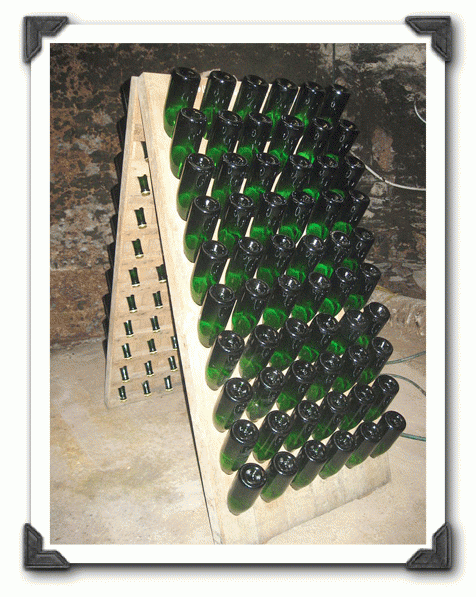
Champagne bottles in riddling racks
(Image by (From Wikimedia) Manikom, Author: Manikom) Details Source DMCA
The true genius of her innovative vision was to make the law of gravity work for her. She had wooden racks built in an inverted V shape, each rack containing a number of bottle-sized holes into which the young wine could be placed. The bottles were placed at an angle, upside-down in the racks, so that their bottoms faced upward. In this position, the "lees," that is, the sticky yeast filaments, small particles, and other undesirable solids, gradually slid into the neck of the bottle. To facilitate the clarifying process, Mme. Clicquot directed the cellar workers to turn the bottles by hand. After experimentation, she found that rotating them a quarter-turn each day for six to eight weeks gave the best results.
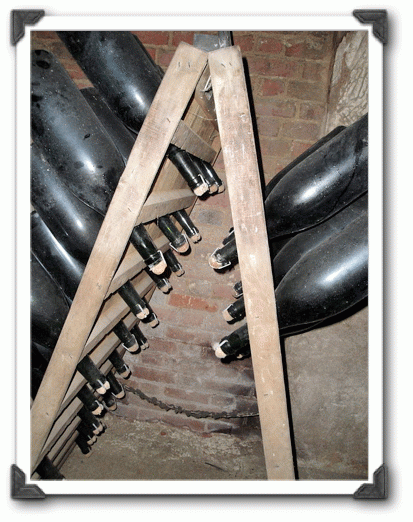
Champagne riddling, detail.
(Image by (From Wikimedia) Tomas er, Author: Tomas er) Details Source DMCA
As the mother of the methode champenoise, Barbe-Nicole knew she had an organic and noble product that was head and shoulders above the competition, so she did her utmost to keep her innovative techniques a secret. Not only did she have the only clear-as-crystal, drinkable champagne, she had a generous amount of a Great Comet vintage. Historians and oenophiles alike would later praise the 1811 wine harvest as one of the best vintages of the 19th Century.
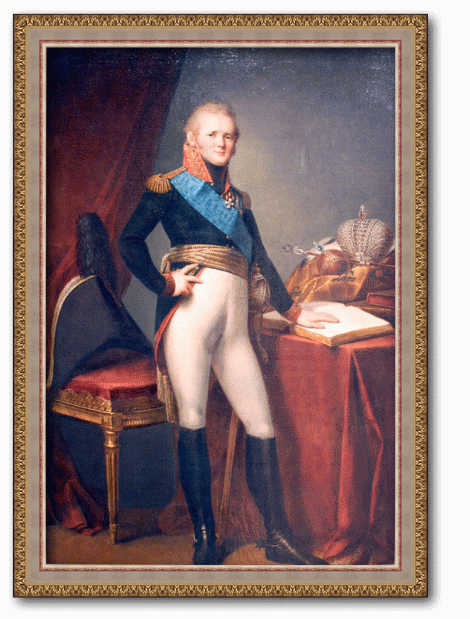
Russian tsar Alexander I.
(Image by (Not Known) Public domain via wiki, Author: Author Not Given) Details Source DMCA
But the Napoleonic Wars still raged on, as she fought in vain to find a single port from which to ship her champagne. Finally, with a combination of cunning, patience, and skullduggery, Nicole Clicquot managed to smuggle her precious cargo through a maze of naval blockades into the North Sea and then further north into the Baltic, shipping them to the Russian imperial court in faraway St. Petersburg. After Napoleon Bonaparte and his army met disaster in Russia, the Russian army followed him back to France, for a time occupying Nicole's home province of Champagne.
A natural at marketing, the widow had early on learned that Alexander I, the Russian Tsar and the Russian elite liked their champagne very sweet, so she catered to their taste. While in France as occupiers, however, they often demanded bottles of her bubbly without paying. For some while, Clicquot had to grimly tolerate the dire conditions brought about by war.
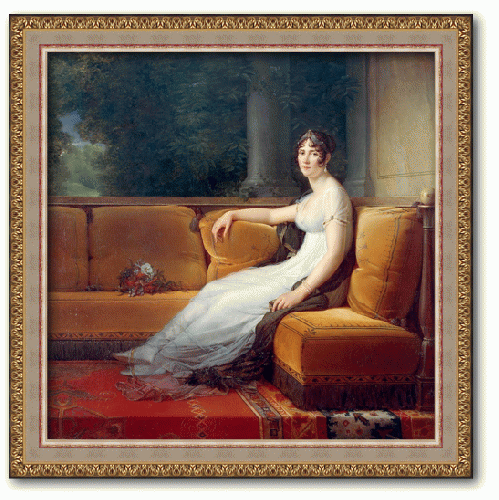
Josephine Bonaparte.
(Image by (Not Known) Public domain via wiki, Author: Author Not Given) Details Source DMCA
By 1814, the wars that France had been fighting, first with the British and then with their own Emperor Napoleon, came to an end. Clicquot's business shot forward like a well-aimed champagne cork, leaving her more sedimentary competitors a distant second. Ironically, one of her most enthusiastic and thirsty customers was Josephine, France's former Empress. She ran up such a champagne tab that it became a hot-button item in her divorce from Napoleon Bonaparte.
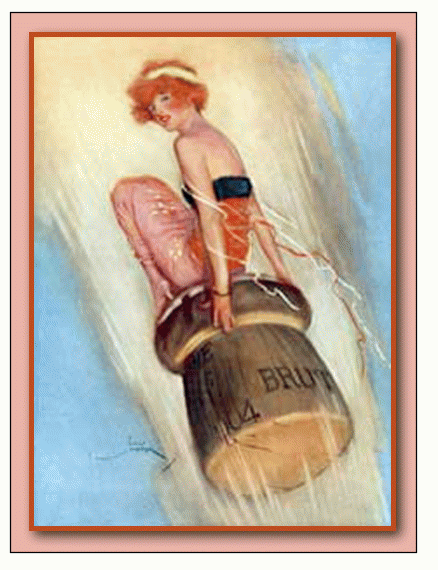
English magazine illustration of a lady riding a champagne cork, 1915.
(Image by (Not Known) Public domain via wiki, Author: Author Not Given) Details Source DMCA
In peacetime, others began to imitate La Veuve's champagne and even plagiarize, an easier trick to pull off then, when wine bottles seldom bore labels. Ever the clever problem-solver, Nicole began to use corks marked with her distinctive initials and a star, symbolic of the Great Comet. Coolly prepared to butt heads, this French businesswoman with a global outlook also went to court on various occasions to defend her champagnes against fakes in the marketplace.
After Clicquot came up with her winning way of making her jewel-like, transparent champagne, she ably peddled her product to the four corners of the globe. She also won a devoted new following across the Atlantic. Like their French counterparts, women in America appreciated Nicole's breakthrough. At that time, the United States was awash in rum, beer, gin, whiskey, and other far-from-genteel drinks--not a romantic bit of effervescence in the bunch--until she made her splash.
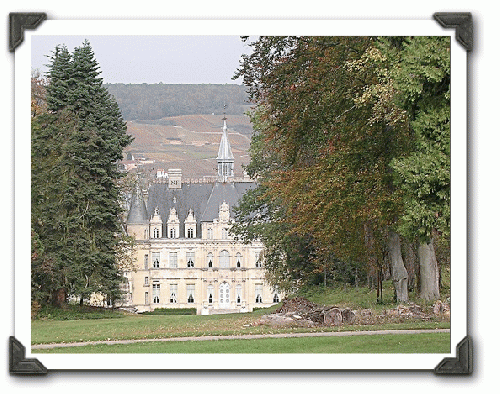
Barbe-Nicole Clicquot's Boursault chateau.
(Image by (From Wikimedia) User:Denys, Author: User:Denys) Details Source DMCA
Madame Clicquot Ponsardin was able to retire while still in her forties, to her chateau de Boursault in Boursin, where she lived to a robust and hearty 89, still getting her daily exercise by lifting a glass of bubbly. It appears that during her lifetime, the salty, plain-spoken La Veuve herself became a stellar attraction at the Clicquot-Ponsardin winery. Thus it's not surprising that in a recent biography, she is quoted as saying in a letter to her great-grandchild, "The world is in perpetual motion, and we must invent the things of tomorrow," urging her young relative to act with audacity. That was advice she herself certainly lived by, throughout her effervescent and comet-spangled life.
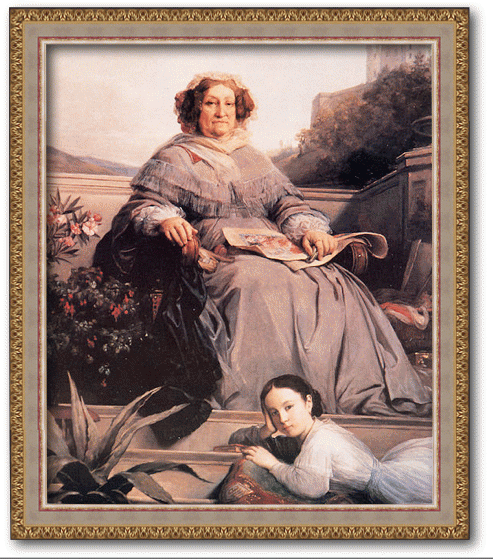
Mme Clicquot and her great-granddaughter Anne with Chateau Boursault in background.
(Image by (Not Known) Public domain via wiki, Author: Author Not Given) Details Source DMCA
Editor's note: In July 2010, 168 bottles of champagne were discovered on board a shipwreck in the Baltic Sea by Finnish diver Christian Ekstrom. This find included 46 bottles of Veuve Clicquot. Since the shipwreck has been dated between 1800-1830, it is possible that some of these bottles may be from the 1811 vintage, the Year of the Comet.
Of the 168 bottles, 79 were well preserved and drinkable, due to the fact that they luckily landed horizontally and remained under pressure, cool, and in the dark for two centuries. In 2011 a bottle of Veuve Clicquot from this shipwreck was auctioned for a record-setting $37,000. Mme. Clicquot would be proud.
This article is drawn in part from entries in Vicki Leon's book, 4000 Years of Uppity Women, available from Barnes & Noble; and from Uppity Women of the New World, out of print but available in limited quantities from the author at www.vickileon.com.
Editing (text and photos) by Managing Editor Meryl Ann Butler.


